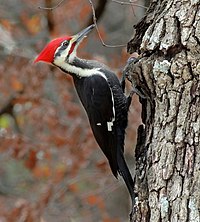
Photo from wikipedia
Molecular phylogenetic studies of woodpeckers (Picidae) have generally focused on relationships within specific clades or have sampled sparsely across the family. We compared DNA sequences of six loci from 203… Click to show full abstract
Molecular phylogenetic studies of woodpeckers (Picidae) have generally focused on relationships within specific clades or have sampled sparsely across the family. We compared DNA sequences of six loci from 203 of the 217 recognized species of woodpeckers to construct a comprehensive tree of intrafamilial relationships. We recovered many known, but also numerous unknown, relationships among clades and species. We found, for example, that the three picine tribes are related as follows (Picini, (Campephilini, Melanerpini)) and that the genus Dinopium is paraphyletic. We used the tree to analyze rates of diversification and biogeographic patterns within the family. Diversification rate increased on two occasions during woodpecker history. We also tested diversification rates between temperate and tropical species but found no significant difference. Biogeographic analysis supported an Old World origin of the family and identified at least six independent cases of New World-Old World sister relationships. In light of the tree, we discuss how convergence, mimicry, and potential cases of hybridization have complicated woodpecker taxonomy.
Journal Title: Molecular phylogenetics and evolution
Year Published: 2017
Link to full text (if available)
Share on Social Media: Sign Up to like & get
recommendations!